________________
BUCHBESPRECHUNGEN/COMPTES RENDUES
705
prayatnāntariyakatva to be a universal, prayatnāntarīyaka must be a substance, a quality, or a movement. But the substances, qualities and movements are enumerated in the Vaišeșika system, and prayatnāntarīyaka does not figure among them (nor do dhūmavat and agnivat). The fact that Vaišeşika accepted the category of universals, did not bar them from using the suffix -tva, like everyone else, in less ontologically burdensome ways.
Nenninger's book is the work of a philosophical, not a philological interpreter (p. 12). He yet offers a philological analysis (pp. 52 ff.) of the first lines of the section studied, which deserves our attention. This passage enumerates the three conditions of the linga 'Beweismerkmal' '[inferential] sign'. The passage is remarkable in that it contains a kind of definition of the correct [inferential] sign, which is presented in two different forms: first in verse, next in prose. Nenninger thinks there are reasons to believe that the two verses here presented were quoted from another work, whereas the prose paraphrases were written by Prasastapada himself. Let us consider his reasons.
I am not sure whether Nenninger has succeeded in showing that the paraphrase assigns two different meanings to the one word anumeya in the first verse. But I think there can be no doubt that he is right in his view that the verse (originally, or even as understood by Prasastapāda) uses the word anumeya in the sense anumeyadharma 'property to be inferred', and defines the linga in these terms, whereas the paraphrase uses this term in the sense pratipipădayişitadharmavisista dharmin "Beschaffenheitstrager, welcher ausgezeichnet ist durch die Beschaffenheit, von der man wunscht, sie erkennen zu lassen" (tr. Nenninger p. 38); in English: 'propertypossessor characterized by the property which one wishes to make known'. If we think of the common example "the hill has fire, because it has smoke" - where, of course, the linga is smoke -, the anumeya is fire in the verse, whereas the paraphrase considers 'the hill as characterized by fire' to be the anumeya.
This difference between verse and paraphrase gains interest in view of the fact that Dignåga, in his Pramāṇasamuccaya, discusses the question what exactly is to be inferred: the property-possessor (dharmin; in our example the hill), the property (dharma; fire), or a combination of the two. Dignāga himself holds that what is to be inferred is the property-possessor characterized by the property (dharmavisista dharmin), and he calls it
6
H
He does not discuss the fact that the verse uses the verbal form sambaddham, whereas the paraphrase has sahacaritam. We may have to read the paraphrase as one concerning the whole first line, not each individual word.




